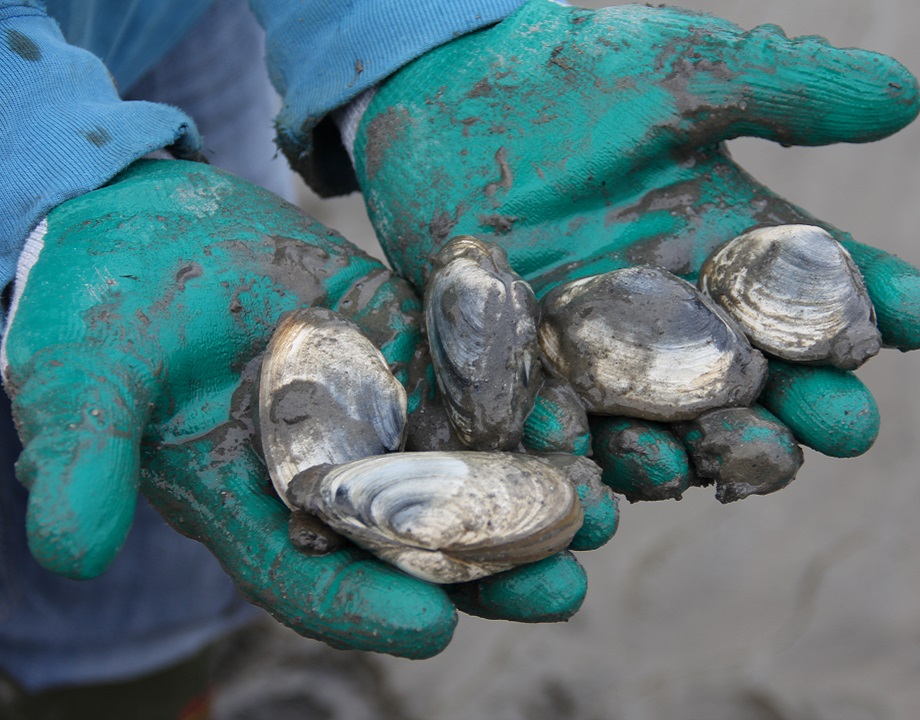
Jessie Batchelder
Fisheries Project Manager
Over the past few months, Jessie Batchelder, Manomet’s Fisheries Project Manager, has been immersed (quite literally, sometimes!) in vital research focused on protecting critical coastal ecosystems in Casco Bay and beyond. As part of a two-year grant aimed at understanding stressors on eelgrass beds—an area where staggering loss has occurred—Jessie has been working with the Casco Bay Estuary Partnership, Friends of Casco Bay and Team Zostera to understand stressors on eelgrass beds. Manomet’s role in this work has been trapping invasive green crabs to understand population differences in beds of differing status. This season marked the completion of year one, with her team gathering crucial data on green crab abundance and their impact on fragile eelgrass habitats.

In addition to the eelgrass project, Jessie has been busy with a range of other marine conservation efforts. In late September, she wrapped up an oyster purchasing initiative funded through The Nature Conservancy SOAR (Supporting Oyster Aquaculture and Restoration) Program to buy “doubles” and “uglies” from oyster farms on the New Meadows River and followed it up with post-deployment SCUBA surveys to monitor the survival, growth and recruitment of new oysters on the budding reefs. Blue crab trapping efforts are still underway even though it’s starting to get chilly out on the water (it was 35˚F at 7:30am earlier last week)! The traps will stay in the water until early November when most of the blue crabs have moved into deeper water or buried in the mud to wait out the winter. This fall, she has collaborated with Bowdoin College’s Coastal Studies Semester program, giving a guest-lecture and working with students who are doing their own trapping and conducting independent research projects focused on blue crab diets and their influence on native shellfish populations.

Manomet fisheries team’s work also focuses on quahog growth and survival, partnering with the town of Brunswick Marine Resource Committee and Eros Oyster Farm to look at the viability of growing quahogs in the intertidal zone. Data from the work shows promising results, with high survival and growth rates over the summer. The team will analyze the findings and prepare a final report by early next year. They are also overseeing a National Oceanic and Atmospheric Administration (NOAA) funded work aimed at creating partnerships between oyster farms and municipal shellfish committees where oysters farms grow quahogs to a size where they can survive predation from green crabs. The quahogs can then be sold to municipalities for stock enhancement at a bigger size than is available from the hatcheries and saves municipalities from having to undergo the nursery stage of quahog growth, which can be quite time- and cost-intensive. Quahogs from one farm have reached the target size and will be spread on clam flats in Brunswick next month.

With the fall season closing in, Jessie is preparing to conduct the final intertidal crab surveys for the year as part of Manomet’s long-term monitoring program. For five years, she and the team have monitored green crab populations at three specific sites in Casco Bay, contributing valuable data to understand the dynamics of these invasive species. These surveys are an essential part of tracking how green crab populations fluctuate throughout the year and their ongoing impact on local ecosystems.
The fisheries team has work that is currently funded by Maine Sea Grant Biennial Funds, and in early October, Jessie and her colleagues Emily Farr, Senior Fisheries Program Manager, and Anne Zegers, Sea Run Fisheries Monitoring Coordinator, attended the Maine Sea Grant Research Symposium at University of Maine, Orono. Manomet is the lead on river herring focused research and are co-Principal Investigators with the Wells National Estuarine Research Reserve on work focused on blue crabs. At the event, Emily sat on a panel to discuss the river herring work, and the blue crab work was also featured on the panel. Emily’s intern Sophie Chivers (who recently graduated from College of the Atlantic) also had a poster on display to invite conversation with attendees about Manomet’s river herring work.
From oyster beds to green crab monitoring, Jessie Batchelder’s recent work reflects a holistic approach to understanding and addressing the challenges facing coastal ecosystems in Maine. Through her research and collaborations, she is helping to protect the region’s marine life for future generations.








